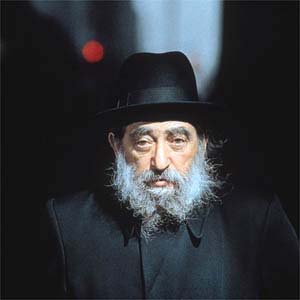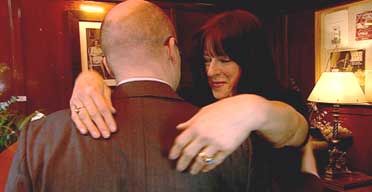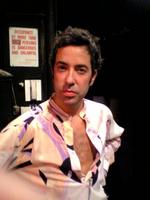With its eye on the Chinese market, Disney is producing a martial arts remake of Snow White.
Yuen Woo-ping, the wire fighting guy from everywhere, is directing, and Michael Chabon is writing the screenplay. Too bad it’s not animated. This could be horribly, horribly wrong, or oh-so right.
Snow White and the seven kung fu monks: Disney sets sights on China [guardian, via robotwisdom]
Author: greg
Out Of The Mouths Of Babes
A scene this past weekend at a wedding in the Hudson River Valley:
At dusk, a 6-year-old boy would charge up to the younger kids and, with his fists full of sparklers, he would roar and shake his hands until they would run away crying.
When the sparklers went out, he marched around proudly, shouting, “I am the dominant democracy! I am the dominant democracy! Did you see them? They bow down to me!”
Happy Fourth of July!
Who Has Final Cut At The Lincoln Memorial?
About that 8-minute short subject documentary showing at the Lincoln Memorial, the one about all the people who use “America’s Soapbox” to protest in support of their causes? Well, the Religious Right screened the first cut, and they loved it, they just had a few notes… Aww, who’re we kidding? They hated it, and they had a ton of notes, which they sent to the producers at the National Park Service. So consider that you’ve been watching the rough cut of history for the last ten years.
Of course, to even see the production notes required a FOIA request, and even then, major portions of the conservative suits’ demands and the NPS’s editing decisions that flowed out of them have been redacted. So until the Extra-Special Impeachment Edition DVD comes out sometime after Jan. 20, 2009, this is about all we know of their re-edits:
Lincoln Memorial Video May Be Revised [guardian, via robotwisdom]
View Lincoln Memorial’s 8-min short [ap.org]
Robert Melee? He Has A Huge Talent Show
A couple of snaps from Robert Melee’s Talent Show at The Kitchen. With touches of Wigstock, Laugh-in, Blow-up, Moulin Rouge, Merce, Cher, Olivia Newton John fitness video, Puppetry of the–um–and Fischerspooner-meets-Spinal Tap, it’s a NSFW riot.
And don’t forget Robert’s mother. As if you ever could. There’s one more performance, Thursday night at 8. If tickets are available, you should get them.
Robert Melee’s Talent Show 6/30, 8p [thekitchen.org]
The Politicians Have Already Won
” [G]round zero is not really being shaped by architects; it is being shaped by politicians.”
“[Freedom Tower] will be seen by the world as a chilling expression of how we are reshaping our identity in a post-Sept. 11 context.”
[ouroussof, nyt]
Redesign Puts Freedom Tower on a Fortified Base [nyt]
Philip-Lorca diCourtroom

Philip-Lorca diCorcia is being sued by this guy for taking his photograph on the street in Times Square in 2001. More precisely, he’s being sued for exhibiting it, selling it, and publishing it in books, and his gallery, his publishers, and unnamed others who distribute the photo are included in the complaint.
I got this image from the Guardian, which wrongly describes the image as taken in the subway. It was taken on the street, under a construction scaffolding. I ran into P-L several times while he was shooting this series. So sue me.
Photographer sued for taking portrait [gothamist]
Buy Philip-Lorca diCorcia’s Heads for only $22 at Amazon. While you still can. [amazon]
Gee, If Only ‘Policing Artwork’ Were Easier…
George Pataki demanded “an absolute guarantee” that no one be offended by what goes on with the cultural organizations at the WTC site. That’s frankly offensive.
I love that the problem here is couched in terms of politicians’ “difficulty of policing artwork,” not in terms of, say, “a blatantly anti-American demagoguery that mocks the very idea of ‘freedom.'”
Pataki Warns Cultural Groups for Museum at Ground Zero [nyt]
On Francesco Vezzoli’s Mirror To The Art World
 It’s a relief to know that some folks in Venice did know they were being targetted by Francesco Vezzoli’s Biennale-stopping Caligula trailer–and are fans of his work because of it. Our Other Man In Venice was like, “but that’s the whole point–it’s an institutional critique from within the system. Vezzoli is a hustler, and he sees how the system works and is exposing it. And still, he’s best friends with Miuccia.”
It’s a relief to know that some folks in Venice did know they were being targetted by Francesco Vezzoli’s Biennale-stopping Caligula trailer–and are fans of his work because of it. Our Other Man In Venice was like, “but that’s the whole point–it’s an institutional critique from within the system. Vezzoli is a hustler, and he sees how the system works and is exposing it. And still, he’s best friends with Miuccia.”
And after reading about Donatella’s costumes for the Caligula in W, and how Vezzoli describes the work as “mirroring the superficiality of the film industry,” in Vanity Fair, I’m confident that Vezzoli knows what he’s up to. He’d have to be on top of things to be able to shoot the trailer in March, and still able to plant these fashion magazine stories in time for the piece’s Venice debut. To paraphrase Choire Sicha, Francesco’s a master in the medium of publicity machinery.
I’m totally cool with a smart artist exploring–and even taking advantage of and critiquing–systematic vapidity. But it still bugs when the art world looks into the mirror that artist holds up and doesn’t recognize itself.
Related: Marc Spiegler’s look at the Biennale-hype Industrial Complex in Slate; actor Glenn Shadix’s report from the set of Caligula [‘deliciously over-the-top and outrageous and the food was excellent,’], plus photos and VF scans; ‘the best part of the film is the trailer’? on Jen Shiman’s 30-second Bunny Theater.
Earth Art Via Satellite
[via land+living]In the wake of Google Maps’ release, a few sites have started collecting coordinates and satellite images of various earth art works, including Spiral Jetty, Michael Heizer’s Double Negative, James Turrell’s Roden Crater, and Walter deMaria’s Lightning Field.
Here’s my own contribution, a Google Map view of The Chinati Foundation in Marfa, TX. You can see Judd’s large concrete sculptures lined up in the field, the twin barrel vaulted warehouses with milled aluminum boxes inside, the arcing row of converted barracks-installations, and the Judd-altered gymnasium on the left.
Looking for Earth Art With Google Maps [petermorse.com.au]
Monumental Land Art [daringdesigns.com]
Chinati Foundation [chinati.org]
Don’t Ask Me How Many TV’s I Have
 In the NYT, Edward Lewine talks to some collectors of video- and projection-based art to find out what it’s like to actually live with work that demands both attention and extra hardware.
In the NYT, Edward Lewine talks to some collectors of video- and projection-based art to find out what it’s like to actually live with work that demands both attention and extra hardware.
I know collectors who have flatscreens propped all around the house and long shelvesful of viewing copies of their work; whatever they have playing when you visit, you still read and assess the spines of their VHS’s the way you would their book collection.
And although we have some TV’s that we’ve archived because the artist considers them integral, sculptural elements of the piece, there are other multi-channel pieces where we’ve gotten rid of all but one or two flatscreens (which now double as our TV’s) until we need to exhibit it again as per the artist’s original schematics.
But then there’s the projected piece, where I’ve duped 100 slides off of the dupe of the master that the artists provided [the slides burn out after a few weeks of constant projection]. And then I still have to scour ebay for good old slide projectors, because they sure don’t make’em like they used to.
PS what’s up with the Kramlich’s built-for-video Herzog & deMeuron house in Napa? Haven’t heard much of that lately.
Art That Has to Sleep In The Garage [nyt]
Watch an excerpt of Robert Smithson & Nancy Holt’s 1969 film, Swamp, which gets mentioned in the piece. [robertsmithson.com]
It Depends On What The Meaning Of ‘Freedom’ Is
Upset that the Wall Street Journal is having all the fun, what with all the Bush Republican-campaigning sisters of dead Sept. 11th pilots demagoguing about whose “truth” is in and whose “propaganda” is out at the WTC site, the New York Daily News tried to gin up a controversy of its own about, of all things, The Drawing Center.
At least the critics of the International Freedom Center’s are sophisticated (sophistry-cated?) enough to demand that no politically distorted manipulations of “history” or “freedom” be allowed to cloud the memories of the people who were killed on Sept. 11th. [Except, of course, the revealed truth of the Gospel according to the Bush Administration, but who’d ever doubt that? Terrorists and their friends, that’s who.]
Left to pick up the crumbs of the new Political Correctness table, the Daily News got suddenly outraged at “anti-American” art–four pieces that have been critical of George Bush or the US–shown at The Drawing Center since 2001, and “demanded” that something be done about it. Doing his best combover and his steeliest resolve, George Pataki declared that he’ll never let any anti-American art be shown at the WTC site.
Governor, I know Rudy Giuliani. Rudy Giuliani was a pandering, fascistic, constitutionally guaranteed freedom of artistic speech-trampling mayor of mine. And you sir, are no Rudy Giuliani. Not for lack of trying, though.
Nutty 9/11 Art Nixed [nydn]
Meanwhile, the NYDN, for one, welcomes our new government overlords [nydn]
Get the Picture, Governor? [nydn]
Previously (06/2004): WTC Site Cultural Anchor: The Drawing Center?? Ironically, the Daily News cites the vast, painstakingly investigated and researched [!] schematics of the late artist Marc Lombardi. The work they complain about maps out ties between the George W. Bush’s Harken Energy, the Saudi royal family, and the Bin Laden family. The title says, “fifth version, 1979-1990.” It was made in 1999. Lombardi took his own life in 2000.
Mad Hot Clearances
Once again, a highly acclaimed documentary is nearly wrestled to the ground by the exorbitant cost of clearing the rights to music–including a ringtone–that appears in the film. Not talking about the soundtrack here, either, but the diagetic (i.e., in-story, on-camera) sound that permeates the real world where the filmmakers shot.
This time, it’s Mad Hot Ballroom, directed by Marilyn Agrelo and produced by Amy Sewell. The filmmakers spent $140,000, 45% of their budget, to clear the rights. Stay Free! interviewed Sewell about the IP challenges they faced, which went well beyond the music:
Well, we had to watch out for billboards and Frito-Lay trucks all the time. But I usually didn’t care, we would just shoot. The biggest danger with clearances is when they interfere with documenting real life. Something spontaneous like a cell phone ringing is different than a planned event. If filmmakers have to worry about these things, documentaries will cease to be documentaries! What happens when the girls go shopping and there’s music playing in the stores? We were lucky because in our movie the music wasn’t identifiable, but otherwise what are we supposed to do: walk up to the store manager and say, “Excuse me but can you turn off your radio?”
That sucks. Of course, we say that all the time when we go into stores. It can be an audio pain to edit a scene with a song playing through it.
How did Mad Hot Ballroom survive the copyright cartel? [stay free! via waxy]
Previously: Clearing Tarnation cost approximately 2,200 times that film’s $218 production budget.
Bring The Spiral Jetty Into Your Home!
 Do you ever wish you still had those Matisse Cutout posters from freshman year? Well, the good old days are back, my art advertising-loving friend.
Do you ever wish you still had those Matisse Cutout posters from freshman year? Well, the good old days are back, my art advertising-loving friend.
BetterWall will sell you an actual, cleaned up, polyvinyl street banner from your favorite museum exhibition–or, if that one’s sold out, from some other exhibition you chose to make yourself look sophisticated– that’s ready for hanging right in your own home!
They’re cheaper than art, but hella more expensive than posters. But if you’ve got $300-1800 to spend, and you don’t want to buy actual art for some reason, BetterWall is for you.
Buy one of 30 Robert Smithson Spiral Jetty banners from the 2004 MoCA retrospective, $549 [betterwall.com, via nyt]
Young, Dumb, and Full Of Coke

You have to admit, she does look rather mannish.”
For a brief moment in the early 90’s, The Modern Review was really good, almost a smarter, smugger Spy, if such a thing can be imagined. Then it started to turn in on itself, then it imploded in a brawlful of recriminations between its two egomaniacal founders Julie Burchill and Toby Young [who both happened to bed the magazine’s soap-operatically named would-be-usurper/editrix Charlotte Raven] and then–jump forward ten years so I don’t have to recount the whole annoying Vanity Fair Toby Young saga again, thank you–well, and then Monday at 9PM GMT, Mark Halliley’s documentary about the coke-fuelled rise and fall of MR airs on BBC4.
From his account of the making of in the MediaGuardian, the whole show is a bunch of self-absorbed liars and cokeheads in various stages of denial and/or sobriety who continue bitching about each other instead of doing something more productive with their once-promising talents. Which sounds about right. Enjoy.
[And this, from someone who counts Toby as a friend of two different friends.]
Julie and Toby in the hall of mirrors [mediaguardian.co.uk]
Sleepwalkers at White Columns
One of my top picks of 2004 for film/video art, Sleepwalkers, by the British collective Inventory, will be included in the first ever US installation of their work at White Columns. It opens Friday 17 June and runs through 23 July.
Sleepwalkers was filmed at an “Americana” festival in the UK, where Britons gather to celebrate such high-minded touchstones of American culture as monster trucks, RV’s, and big rig tractor trailers with huge, pimped out sleeper cabs in the back. If White Columns’ a-rockin’, don’t bother knockin’, just go on in.
Other People’s Projects: Inventory [WhiteColumns]
Previously: My 2004 Video Art Top Ten Seven


